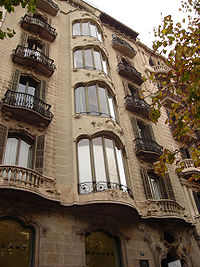
Rambla de Catalunya, Barcelona
Encyclopedia


Barcelona
Barcelona is the second largest city in Spain after Madrid, and the capital of Catalonia, with a population of 1,621,537 within its administrative limits on a land area of...
, Catalonia
Catalonia
Catalonia is an autonomous community in northeastern Spain, with the official status of a "nationality" of Spain. Catalonia comprises four provinces: Barcelona, Girona, Lleida, and Tarragona. Its capital and largest city is Barcelona. Catalonia covers an area of 32,114 km² and has an...
, Spain
Spain
Spain , officially the Kingdom of Spain languages]] under the European Charter for Regional or Minority Languages. In each of these, Spain's official name is as follows:;;;;;;), is a country and member state of the European Union located in southwestern Europe on the Iberian Peninsula...
that runs West-East (or "mountain-sea") through the Eixample
Eixample
The Eixample is a district of Barcelona between the old city and what were once surrounding small towns , constructed in the 19th and early 20th centuries....
district. One of the city's trendiest streets, with many international fashion shops, and lined with lime trees
Tilia
Tilia is a genus of about 30 species of trees native throughout most of the temperate Northern Hemisphere. The greatest species diversity is found in Asia, and the genus also occurs in Europe and eastern North America, but not western North America...
, it is located between Passeig de Gràcia and Carrer de Balmes, being strictly parallel to the latter, and between Avinguda Diagonal to the west and Plaça Catalunya to the east. It can be seen as an extension into the Eixample
Eixample
The Eixample is a district of Barcelona between the old city and what were once surrounding small towns , constructed in the 19th and early 20th centuries....
of the famous Rambles.
Notable buildings
- No. 17. Casa Pia Batlló, by Josep Vilaseca i CasanovasJosep Vilaseca i CasanovasJosep Vilaseca i Casanovas was a Catalan architect and artist who formed part of the Modernista movement.He studied architecture in Madrid and qualified in 1873. He travelled with Lluís Domènech i Montaner in Germany...
, 1891–96
- No. 47. Casa Fargas, by Enric Sagnier i VilavecchiaEnric SagnierEnric Sagnier i Villavecchia was a Catalan architect of Spanish nationality.Although now not as well known as his contemporaries Antoni Gaudí, Lluís Domènech i Montaner and Josep Puig i Cadafalch, he was responsible for a number of landmark buildings, was very prolific, and could turn his hand to...
, 1902-04. An example of the architect's mature Modernista period.
- No. 54. Casa Dolors Calm, originally by Josep Déu i Busquets, 1879, and remodelled in 1903 by Josep Vilaseca i Casanovas
- No. 78. Casa Juncosa, by Salvador Viñals i Sabater, 1907-09.
- No. 115. Church of La Mare de Déu de Montsió. Originally built in about 1400 on a site near what is now the Plaça Catalunya and moved here in 1882 by the architect Joan MartorellJoan MartorellJoan Martorell i Montells was a Catalan architect and designer. He was an uncle of the architect Bernardí Martorell i Puig....
.
- No. 122. Casa Antoni Costa, by Josep Domènech i EstapàJosep Domènech i EstapàJosep Domènech i Estapà was a Catalan architect.He graduated in 1881, and became professor of geodesy and descriptive geometry at the University of Barcelona, and member of the Acadèmia de Ciències i Arts , of which he subsequently became president.His works in Barcelona include the church of...
, 1904.
- No. 126. Casa Serra, by Josep Puig i CadafalchJosep Puig i CadafalchJosep Puig i Cadafalch was a Spanish Catalan Modernista architect who designed many significant buildings in Barcelona...
, 1903-8, in a neo-Romanesque style.
Cinema
- Alcázar
- Alexandra Lauren
- Alexis
- Club Coliseum
- Pathé (opened 1923), no longer exists.
Theatre
- Teatre Barcelona was one of the most iconic theatres in the city that unfortunately had to be pulled down.
Sculptures
- La girafa coqueta (1972) by Josep Granyer - on its Western end, by Avinguda Diagonal.
- El toro assegut (1972) by Josep Granyer - on the crossing with Gran Via de les Corts Catalanes.
Hotels
- Gallery Hotel
- Hotel Continental Palacete
- Hotel Eurostars Cristal Palace
- Hotel NH Calderón
- Hotel Ònix Rambla
- Regente Hotel
- Hotel moderno Barcelona Hotel ramblas barcelona

